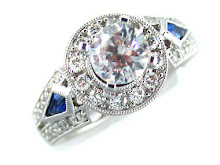 The Retro jewelry period began in the 1930s during the depression years and lasted until 1950. Retro is often called Cocktail Jewelry due to unusual mixture of stones and bold, highly polished gold golds (mostly rose, yellow and green).
The Retro jewelry period began in the 1930s during the depression years and lasted until 1950. Retro is often called Cocktail Jewelry due to unusual mixture of stones and bold, highly polished gold golds (mostly rose, yellow and green).  Retro jewels often feature massive, emerald-cut aquamarines, citrines and amethysts, accented with smaller rubies, sapphires and diamonds.
Retro jewels often feature massive, emerald-cut aquamarines, citrines and amethysts, accented with smaller rubies, sapphires and diamonds. Yellow gold quickly became the metal of choice as platinum was unavailable during the war times, as well as natural gemstones. They were successfully replaced by synthetic ones. Retro bracelets, watches and necklaces reflected the glamour and enchantment that Hollywood inspired during times of crisis. The movies provided a wartime escape into a world of fantasy and romance that was
Yellow gold quickly became the metal of choice as platinum was unavailable during the war times, as well as natural gemstones. They were successfully replaced by synthetic ones. Retro bracelets, watches and necklaces reflected the glamour and enchantment that Hollywood inspired during times of crisis. The movies provided a wartime escape into a world of fantasy and romance that was  "larger than life". Clips and brooches in the 40's were swollen to a spectacular scale. The ribbon bow was the most popular motif, often highlighted in the center with a calibré cut ruby or sapphire knot.
"larger than life". Clips and brooches in the 40's were swollen to a spectacular scale. The ribbon bow was the most popular motif, often highlighted in the center with a calibré cut ruby or sapphire knot.
In the mid thirties, Van Cleef & Arpels designed a flexible interlocking honeycomb bracelet with a large ornate buckle. It was named the "Ludo" bracelet after its designer Louis "Ludovic" Arpels. It was actually inspired by some of the early Victorian gold mesh garter bracelets. This would become one of their most
 popular pieces of those times. It was copied by many other jewelry manufacturers and continued to be in great demand throughout the 40's.
popular pieces of those times. It was copied by many other jewelry manufacturers and continued to be in great demand throughout the 40's.Here are some significant features of the era:
- Square shapes and emerald cut stones.
- Massive gems, including synthetic rubies, emeralds and sapphires.
- Bold, highly polished yellow gold.
- Birds, baskets of flowers, dancers and other serene images were common motifs.
 Charms came into vogue during this era and were worn in large quantities on link bracelets. Illusion settings in engagement rings with carved settings, gave the look of a much larger diamond for a modest price tag. These beautiful pieces were favored by the economy minded women of the 1930's and are just as popular today. These designer pieces are highly collectible to this day.
Charms came into vogue during this era and were worn in large quantities on link bracelets. Illusion settings in engagement rings with carved settings, gave the look of a much larger diamond for a modest price tag. These beautiful pieces were favored by the economy minded women of the 1930's and are just as popular today. These designer pieces are highly collectible to this day.


No comments:
Post a Comment